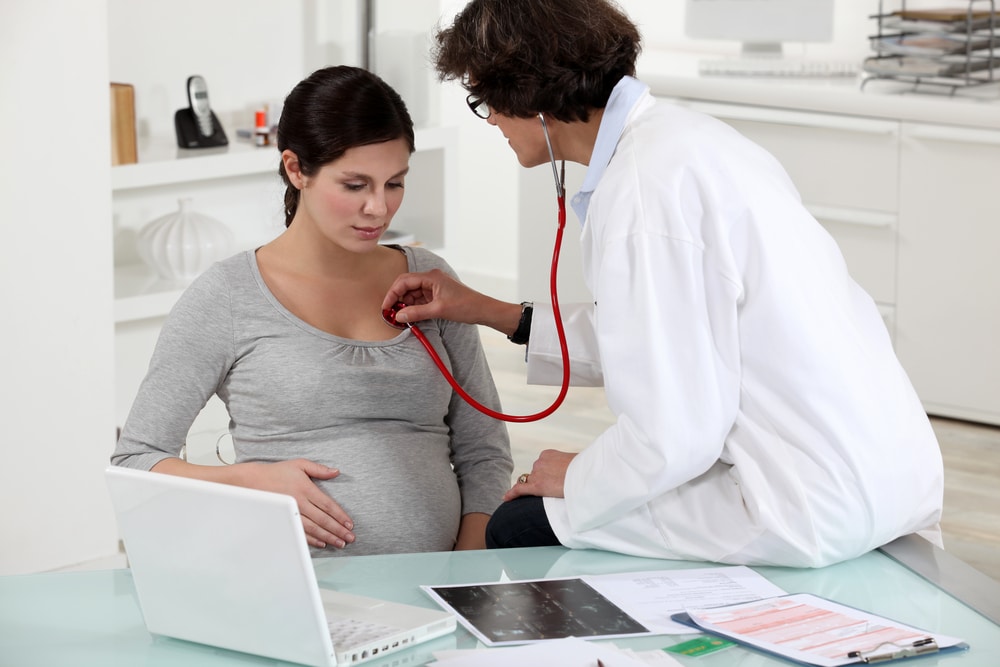There are four high blood pressure disorders you can get during pregnancy. One of the main ones is called preeclampsia. It is a pregnancy complication caused by having high blood pressure that does damage to your organs such as the liver or kidneys. This is usually caused by the blood vessels in the placenta not developing correctly or they don’t function how they are supposed to. When the blood vessels in the placenta aren’t developed or functioning it results in insufficient blood flow to the uterus. This can mean that there is damage to the vessels, cause a problem with the immune system, or because of certain genes that the mother has. Preeclampsia is one of the leading causes of mom and infant deaths and there is no real way to prevent it. Â
Though there is no way to prevent it there are ways to diagnose it. Usually during your pregnancy after week 20 if you have consistent high blood pressure your doctor will start to look for other signs of preeclampsia. Your high blood pressure with have to be accompanied by one of the following, protein in your urine, low platelet count, impaired liver function, kidney problems, fluid in the lungs, headaches or vision problems. During a routine prenatal appointment your doctor can run some tests if your blood pressure is high. They can do a blood test check, a urine analysis, or a fetal ultrasound. The blood test will check for the function of the liver and kidneys.  A urine analysis will check for the protein in the urine. And a fetal ultrasound with check on the baby’s growth. Â
The main treatment for preeclampsia is delivery. If your baby is not far enough along in your pregnancy then your doctor may increase the amount of visits you have so he can keep a closer look on you. Also you may be put on bed rest to try and lower your blood pressure. In some instances that relaxing from bed rest doesn’t calm your blood pressure your doctor may put you on some medication to lower your blood pressure that won’t affect the baby. Â
The most common symptom of preeclampsia is high blood pressure. It is usually the first symptom that is caught by your doctor that will make them check for one of the other indicators. Those indicators would be excess protein in your urine, or impaired liver or kidney function. Some other symptoms that can go along with preeclampsia are severe headaches, change in vision, upper abdominal pain, nausea, vomiting, decreased urine output, decreased levels of platelets in the blood, or shortness of breath. Some other symptoms that go along with high blood pressure is sudden weight gain or swelling of the face and hands. Make sure at your doctor appointments if you are suffering from any of these to discuss them with your doctor. Preeclampsia is very serious, but when caught early enough it can save lives of both mom and baby.Â
 Some people are more at risk of having preeclampsia. People who have had it in a previous pregnancy are more likely to get it in their second pregnancy, but not necessarily guaranteed. If you have chronic high blood pressure before you are pregnant you have a higher risk as well. If you are either very young while pregnant or over 40 you are at greater risk. If you are obese before the pregnancy, carrying multiples, or pregnant through IN VITRO fertilization all are risks. If you have two pregnancies that are less than two years apart or if your pregnancies are more than ten years apart you have a greater risk of developing preeclampsia in your second pregnancy. Â
Even if you develop preeclampsia mom and baby can be ok. Though it is life threatening to both mom and baby. Since it can cause to not enough blood getting to the uterus it can cause infant oxygen deprivation. It can also cause fetal growth restriction, or slow growth in the baby since the baby isn’t receiving enough oxygen. Other complications that could arise from preeclampsia are placenta abruption, which is when the placenta separates from the uterus too early. Organ damage can be caused by preeclampsia, such as damage to the liver or kidneys. For the baby it can cause preterm birth since the main way to treat preeclampsia is to deliver. Preeclampsia can turn into eclampsia, preeclampsia with the addition of having seizures. If your preeclampsia turns into eclampsia, which can cause cardiovascular disease, or cause brain injury from seizures and high blood pressure. Â
Worldwide preeclampsia is the cause of 20% of 13million preterm births. Approximately 10,500 of those babies born preterm because of preeclampsia die from preterm birth. Whether they are born somewhere that doesn’t have the care for preterm babies or because the babies were just too premature to survive. Being premature can cause a baby to develop cerebral palsy, epilepsy, blindness, or deafness. Approximately 63,000 women worldwide with preeclampsia die. In the US and Great Britain it is about 5.6%-11.8% of women with preeclampsia it turns out to be fatal. Preeclampsia turns fatal when doctors don’t treat the high blood pressure leading to extreme high blood pressure that can cause a stroke. Â
Preeclampsia though scary and life threatening if diagnosed properly and early enough can still lead to a healthy baby and mom. Make sure you are getting your prenatal appointments done and you discuss any abnormal symptoms that don’t seem right. At appointments make sure your doctor is checking your blood pressure regularly, and if you feel like your blood pressure is high at home, you can buy a wrist blood pressure cuff at the store to monitor your blood pressure at home. Make sure you rest as much as possible if your blood pressure is high, high blood pressure is not good for you or your baby.
Preeclampsia is one of the leading causes of mom and infant deaths. Learn more here! #HealthStatus
Sources:
mayoclinic.org
preeclampsia.org








Reply